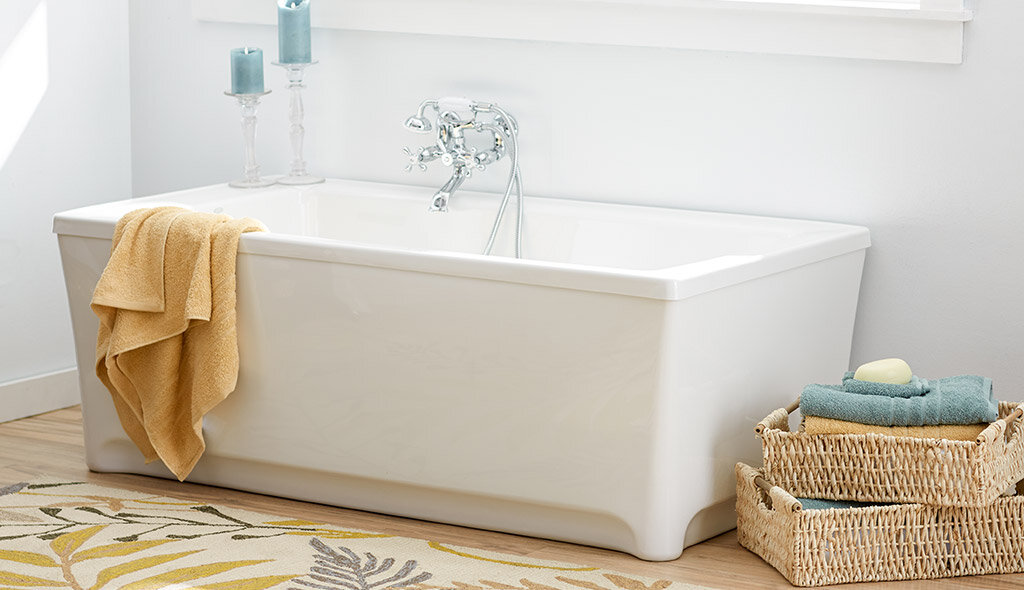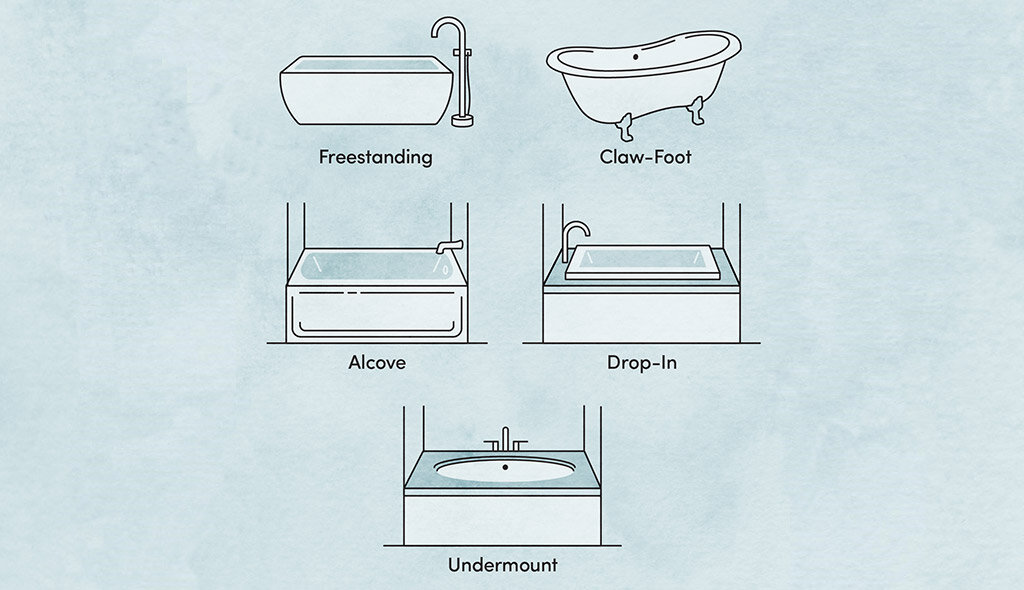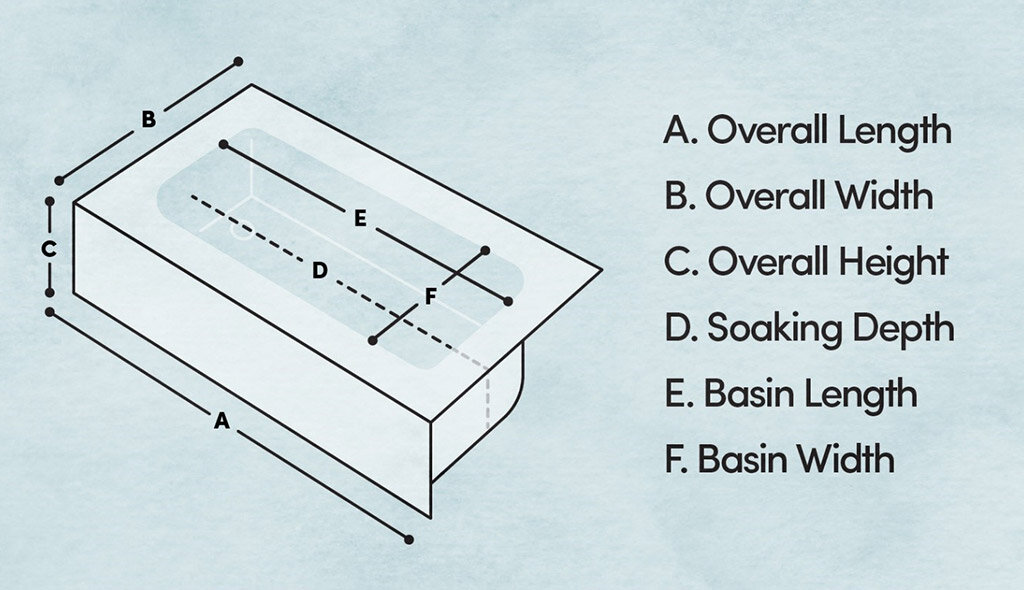From shapes to materials, we’ve covered all the basics. (So you don’t have to.)

When figuring out how to choose a bathtub, start by considering the best options for your space. Take a look at the most popular types of bathtubs, materials, and how to measure for a new tub below.
Most Popular Bathtubs

Freestanding: This stand-alone tub has an exterior faucet attached to the wall or floor. This style offers easy installation and flexible placement in most bathrooms.
Clawfoot: Named for its signature tub-supporting feet, this raised, freestanding-style tub is available with traditional or modern legs. For a high-back option, claw-foot slipper tubs are popular.
Alcove: Built to be installed into the walls of an alcove, this tub has three unfinished sides and one finished side (the apron) that faces outward. Tub-shower combinations are common with this type. A left or right tub orientation indicates that drain and faucet placement will be on that side.
Drop-In: This tub shell has a wide rim and is designed to sit inside an enclosure or frame that’s built separately. More intricate installation may be required.
Undermount: Also designed to fit inside an enclosure, this tub style has a rim that’s covered by a surrounding deck made of stone or tile. More intricate installation may be required.

Corner: This triangular-shaped tub is installed in the corner of a bathroom and is most often an alcove or drop-in style.
Soaking: With higher sides, this tub has increased depth for full submersion.
Whirlpool: This spa-like tub propels jets of water for a soothing massage and hydrotherapy. Installation commonly includes a pump, air switch, electric timer, and access panel for adjustments and maintenance.
Air: This type of bathtub propels jets of air bubbles for a gentler massage. Installation commonly includes a pump, air switch, electric timer, and access panel for adjustments and maintenance.
Walk-In: These tubs include a side-panel door and are ideal for those with limited mobility. Many come with additional safety features, like slip-resistant floors and grab bars.
Bathtub Materials
Acrylic: Lightweight, easy to repair, and available in many colors and shapes, acrylic tubs can be more moderately priced.
Fiberglass: These tubs are lightweight, reparable, and often more affordable than acrylic options.
Cast Iron: Enameled cast iron is durable, solid, excellent at retaining heat, and available in many colors.
Porcelain: Usually made with a cast iron or steel base, porcelain-enameled tubs have an affordable, luxurious look that’s resistant to scratching and will retain its glossy finish for years.
Copper: This artisan option, often constructed with hammered recycled copper, is a costlier but one-of-a-kind finish that grows richer with time.
Granite/Marble: With a one-of-a-kind natural look, stone tubs are often hand-carved and excellent at retaining heat.
Additional Features to Consider
Lights: For Chromatherapy, underwater LED lights change color to suit your mood.
Music: Built-in waterproof speaker panels can output sound and connect to other devices through bluetooth.
Heating: A built-in heating panel can be adjusted to add extra warmth to your back and shoulders.
How to Measure for a New Bathtub
Along with picking the right style, you need to make sure it fits. To find the right size bathtub for your space, grab a tape measure and follow the steps below.

Step 1: Check Your Floors
Before you begin measuring, use a level to ensure your floor is level. This will guarantee accurate measurements and prevent water from spilling over your bathtub onto the floor.
Step 2: Measure the Length of Your Space
If your bathtub will be enclosed in an alcove, measure from wall to wall (side to side) to find the length of available space. When measuring for undermount or drop-in baths, make sure to account for the lip of the tub by measuring at least one inch out from each wall. If your space isn’t constrained by walls, your bathroom floor plan and existing plumbing should determine where your bathtub will go – and how big it can be. The most common bathtub length is 60".
Step 3: Measure the Width of Your Space
To find the distance of usable space, measure from the wall forward, and remember: You’ll need clearance for the swing of any doors, space to access plumbing for any future maintenance, and enough room to get in and out of the bathtub comfortably. The most common bathtub width is 30".
Step 4: Measure the Height of Your Space
Consider bathtub height relative to the floor, factoring in faucet height and existing features like window ledges or electrical outlets. The most common bathtub height is 15" – 16".
Step 5: Consider Basin Size
The length and width of a bathtub’s basin will determine how well you fit inside. To find the interior length, measure from the left side to the right, going down the middle of the tub so you’re measuring the two farthest points. To find the interior width, repeat this measuring process, going from the back inside wall to the front. The most common basin size is 60" x 30".
Step 6: Consider Soaking Depth
The depth of your tub will affect your level of submersion. To find the soaking depth of a tub, measure the inside wall of a bathtub from the base to the overflow drain at its deepest point. The most common bathtub soaking depth is 14" – 17".
Step 7: Consider Tub Capacity
Once you’ve calculated your desired basin size, consider the volume of water it will take to fill. To find a bathtub’s exact capacity in gallons, look under the specifications tab on the right-hand side of a product’s page. Make sure your water heater can fill a basin of that size, and that your floors can support the additional weight of the water. To determine if your water heater is large enough for a bathtub, the general rule is that the water heater tank should be about 2/3 of the size of the bathtub. The most common bathtub capacity is 80 gallons.
Step 8: Measure for Delivery
Determine which entrance to your home has the easiest access for delivery. Then, measure the height and width of all doorways and hallways, to make sure your new tub will make it easily to your bathroom come delivery day.
